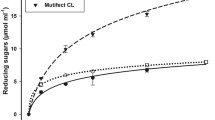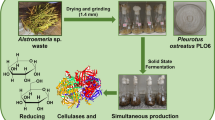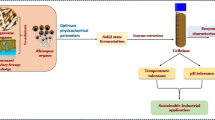Abstract
The lignocellulosic material bioconversion to bioproducts has received significant attention in recent years. Cellulases and hemicellulases catalyze the hydrolysis of lignocellulosic materials into fermentable sugars that are afterward converted to bioproducts by microorganisms. Chrysoporthe cubensis grown under solid-state fermentation (SSF) has produced more effective enzymatic extracts for sugarcane bagasse saccharification than commercial cellulolytic preparations. However, the investigation of new approaches for enzyme production by this fungus is still lacking. In this work, an enzyme cocktail (SSF-SmF-cocktail) was produced by extracting enzymes of C. cubensis grown under SSF using the extract produced by the same fungus under submerged fermentation (SmF). The total cellulase (FPase), carboxymethylcellulase (CMCase), cellobiohydrolase (CBH), β-glucosidase, xylanase, β-xylosidase, β-galactosidase, α-galactosidase, and α-arabinofuranosidase activities were evaluated in crude extracts obtained from C. cubensis cultivation under SSF, SmF, and also in the SSF-SmF-cocktail. The C. cubensis protein profiles cultivated under SSF and SmF were compared by SDS-PAGE. Extract produced by C. cubensis grown under SmF presented proteins with estimated molecular weights of 10.7, 29.3, 38.6, 46.0, and 170.0 kDa, respectively, but not in that produced by this fungus under SSF. When cultivated under SSF, C. cubensis produced an extract with greater protein diversity between 13 and 51 kDa than that obtained by this fungus under SmF. The 83.0 and 95.3 kDa protein bands were present in both C. cubensis cultures. The C. cubensis SSF-SmF-cocktail presented better efficiency in glucose release after 48 h of the alkali-pretreated sugarcane bagasse hydrolysis when compared to those produced by this fungus under either SSF or SmF. This extract showed the highest xylananase/FPase rate and the second highest CMCase/FPase and b-glucosidase/FPase rates among the evaluated extracts, suggesting that these enzymes are the main determinants of this cocktail the efficiency on the alkali pretreated sugarcane bagasse sacchariffication process. These results demonstrated that the enzymes produced by C. cubensis cultivated under SSF and SmF are complementary for the alkali-pretreated sugarcane bagasse enzymatic hydrolysis, since the SSF-SmF-cocktail was more efficient than other extracts produced by this fungus and that the commercial Accellerase®. Therefore, the SSF-SmF-cocktail is a promising alternative for industrial applications.
Graphical abstract



Similar content being viewed by others
Data availability
The datasets generated during and/or analysed during the current study are available from the corresponding author on reasonable request.
References
Acuña-Argüelles ME, Gutiérrez-Rojas M, Viniegra-González G, Favela-Torres E (1995) Production and properties of three pectinolytic activities produced by Aspergillus niger in submerged and solid-state fermentation. Appl Microbiol Biotechnol 43:808–814
Andrade LGA, Maitan-Alfenas GP, Morgan T, Gomes KS, Falkoski DL, Alfenas RF, Guimarães VM (2017) Sugarcane bagasse saccharification by purified β-glucosidases from Chrysoporthe cubensis. Biocatal Agric Biotechnol 12(199):205
Barrios-González J (2012) Solid-state fermentation: Physiology of solid medium, its molecular basis and applications. Process Biochem 47:175–185
Bradford M (1976) A rapid and sensitive method for the quantitation of microgram quantities of protein utilizing the principle of protein–dye binding. Anal Biochem 72:248–254
Champreda V, Mhuantong W, Lekakarn H, Bunterngsook B, Kanokratana P, Zhao X-Q, Zhang F, Inoue H, Fujii T, Eurwilaichitr L (2019) Designing cellulolytic enzyme systems for biorefinery: from nature to application. J Biosci Bioeng 128:637–654
de Albuquerque MFG, Guimarães VM, de Rezende ST (2021) Use of sugar beet flour and wheat bran as carbon source improves the efficiency of Chrysoporthe cubensis enzymes in sugarcane bagasse saccharification. Bioenerg Res 14:1147–1160
de Almeida MN, Falkoski DL, Guimarães VM, Ramos HJO, Visser EM, Maitan-Alfenas GP, De Rezende ST (2013) Characteristics of free endoglucanase and glicosydases multienzyme complex from Fusarium verticillioides. Bioresour Technol 143:413–422
Dutra TR, Guimarães VM, Varela EM, Fialho LS, Milagres AMF, Falkoski DL, Zanuncio JC, De Rezende ST (2017) A Chrysoporthe cubensis enzyme cocktail produced from a low-cost carbon source with high biomass hydrolysis efficiency. Sci Rep 7:3893
Dyballa N, Metzger S (2009) Fast and sensitive colloidal coomassie G-250 staining for proteins in polyacrylamide gels. J vis Exp 30:1431
Falkoski DL, Guimarães VM, De Almeida MN, Alfenas AC, Colodette JL, De Rezende ST (2013) Chrysoporthe cubensis: a new source of cellulases and hemicellulases to application in biomass saccharification processes. Bioresour Technol 130:296–305
Fanaei MA, Vaziri BM (2009) Modeling of temperature gradients in packed-bed solid-state bioreactors. Chem Eng Process 48:446–451
Ghose TK (1987) Measurement of cellulose activities. Pure Appl Chem 59:257–268
Hernández-Pérez AF, Arruda PV, Felipe MGA (2016) Sugarcane straw as a feedstock for xylitol production by Candida guilliermondii FTI 20037. Braz J Microbiol 47:489–496
Holker U, Hofer M, Lenz J (2004) Biotechnological advantages of laboratory-scale solid-state fermentation with fungi. Appl Microbiol Biotechnol 64:175–186
Hu J, Arantes V, Saddler JN (2011) The enhancement of enzymatic hydrolysis of lignocellulosic substrates by the addition of accessory enzymes such as xylanase: is it an additive or synergistic effect? Biotechnol Biofuels 4:36
Inoue H, Kitao C, Yano S, Sawayama S (2016) Production of β-xylosidase from Trichoderma asperellum KIF125 and its application in efficient hydrolysis of pretreated rice straw with fungal cellulase. World J Microbiol Biotechnol 32:186
Laemmli UK (1970) Cleavage of structural proteins during the assembly of the head of bacteriophage T4. Nature 227:680–685
Maitan-Alfenas GP, Visser EM, Alfenas RF, Nogueira BRG, Campos GG, Milagres AF, De Vries RP, Guimarães VM (2015) The influence of pretreatment methods on saccharification of sugarcane bagasse by an enzyme extract from Chrysoporthe cubensis and commercial cocktails: a comparative study. Bioresour Technol 192:670–676
Mendonça EHM, Avanci NC, Romano LH, Branco DL, Pádua AX, Ward RJ, Neto AB, Lourenzoni MR (2020) Recombinant xylanase production by Escherichia coli using a non-induced expression system with different nutrient sources. Braz J Chem Eng. https://doi.org/10.1007/s43153-019-00004-x
Miller GL (1959) Use of dinitrosalicycilic acid reagent for determination of reducing sugars. Anal Chem 31:426–430
Olsen PO, Alasepp K, Kari J, Cruys-Bagguer N, Borch K, Westh P (2016) Mechanism of product inhibition for Cellobiohydrolase Cel7A during hydrolysis of insoluble cellulose. Biotechnol Bioeng 113:6
Rao RS, Jyothi CP, PrakashamRS SPN, Rao LV (2006) Xylitol production from corn fiber and sugarcane bagasse hydrolysates by Candida tropicalis. Bioresour Technol 97:1974–1978
Saritha M, Singh S, Tiwari R, Goel R, Nain L (2016) Do cultural conditions induce differential protein expression: Profiling of extracellular proteome of Aspergillus terreus CM20. Microbiol Res 192:73–83
Singhvi MS, Adsul MG, Gokhale DV (2011) Comparative production of cellulases by mutants of Penicillium janthinellum NCIM 1171 and its application in hydrolysis of Avicel and cellulose. Bioresour Technol 102:6569–6572
Subramaniyam R, Vimala R (2004) Solid state and submerged fermentation for the production of bioactive substances: a comparative study. Int J Sci Nat 3:480–486
Tavares MP, Morgan T, Gomes RF, Rodrigues MQRB, Castro-Borges W, de Rezende ST, Mendes TAO, Guimarães VM (2021) Secretomic insight into the biomass hydrolysis potential of the phytopathogenic fungus Chrysoporthe cubensis. J Proteom 236:104121
Venegas IM, Fuentes-Hernández J, Garcia-Rivero M, Martinez-Treujillo A (2013) Characteristics of Aspergillus niger xylanases produced on ricehusk and wheat bran in submerged culture and solid-statefermentation for an applicability proposal. Int J Food Sci Technol 48:1798–1807
Vicari KJ, Tallam SS, Shatova T, Joo KK, Scarlata CJ, Humbird D, Wolfrum EJ, Beckham GT (2012) Uncertainty in techno-economic estimates of cellulosic ethanol production due to experimental measurement uncertainty. Biotechnol Biofuels 5(1):1-12
Viniegra-gonzález G, Favela-Torres E, Aguilar CN, Rómero-Gomez SJ, Díaz-Godínez G, Augur C (2003) Advantages of fungal enzyme production in solid state over liquid fermentation systems. Biochem Eng J 13:157–167
Visser EM, Falkoski DL, De Almeida MN, Maitan-Alfenas GP, Guimarães VM (2013) Production and application of an enzyme blend from Chrysoporthe cubensis and Penicillium pinophilum with potential for hydrolysis of sugarcane bagasse. Bioresour Technol 144:587–594
Visser EM, Leal TF, De Almeida MN, Guimarães VM (2015) Increased enzymatic hydrolysis of sugarcane bagasse from enzyme recycling. Biotechnol Biofuels 8:5
Zhang X, Tu M, Paice MG (2011) Routes to potential bioproducts from lignocellulosic biomass lignin and hemicelluloses. Bioenergy Res 4:246–257
Acknowledgements
We thank Fundação de Amparo à Pesquisa do Estado de Minas Gerais (FAPEMIG), Conselho Nacional de Pesquisa e Desenvolvimento Tecnológico (CNPq) for the financial support and Coordenação de Aperfeiçoamento de Pessoal de Nível Superior (CAPES) for providing scholarships. We would like to thank Thamires Felisberto Pereira Dutra for cooperating in the experiments execution.
Author information
Authors and Affiliations
Corresponding author
Ethics declarations
Conflict of interest
On behalf of all authors, the corresponding author states that there is no conflict of interest.
Additional information
Publisher's Note
Springer Nature remains neutral with regard to jurisdictional claims in published maps and institutional affiliations.
Rights and permissions
Springer Nature or its licensor (e.g. a society or other partner) holds exclusive rights to this article under a publishing agreement with the author(s) or other rightsholder(s); author self-archiving of the accepted manuscript version of this article is solely governed by the terms of such publishing agreement and applicable law.
About this article
Cite this article
Dutra, T.R., Guimarães, V.M., Varela, E.M. et al. A new approach for Chrysoporthe cubensis cellulolytic cocktail production using solid and submerged-state fermentation. Braz. J. Chem. Eng. 40, 359–366 (2023). https://doi.org/10.1007/s43153-023-00309-y
Received:
Revised:
Accepted:
Published:
Issue Date:
DOI: https://doi.org/10.1007/s43153-023-00309-y




